
Original Link: https://www.anandtech.com/show/2569
A Preview of Intel's Centrino 2 Platform
by Anand Lal Shimpi on July 15, 2008 12:00 AM EST- Posted in
- Laptops
Today is an important day, it's the release of the long awaited Centrino 2 mobile platform (codenamed Montevina) from Intel. Unfortunately, product won't be shipping until August and review samples aren't exactly available so what follows can barely be called a preview. We'll take you through the components that make up Centrino 2 and give some guidance as to how it should perform, but we can hardly provide much in the way of test data.
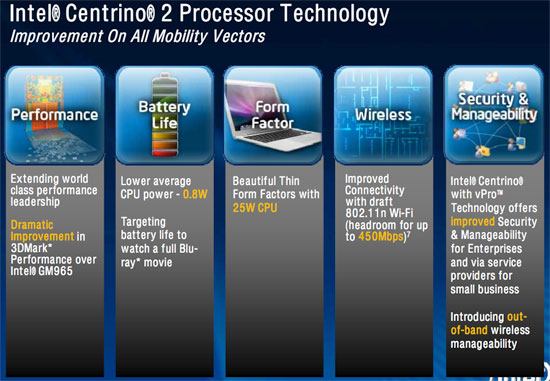
Pretty slide, but where's the hardware?
Where's the Pomp and Circumstance?
For the first significant update to the Centrino name since it was launched in 2002, Intel really dropped the ball on actually putting substance behind today's announcement. The platform itself is what we've come to expect from Intel's mobile team, it looks to have all the right pieces and there's a good mix of innovation and steady evolution here - the problem is that we can't really even begin to test any of the interesting bits, there's hardly any hardware out there to test.
We contacted HP, Dell, Gateway, ASUS and even Hypersonic (a division of OCZ) - not a single company could provide us with a Centrino 2 notebook for review. Intel blames the lack of available hardware on issues with the GM45 chipset as well as incomplete FCC certification on the new wireless adapters. Both issues have either been resolved or are in the process of being resolved, but they pushed the launch back by at least a month; Centrino 2 was supposed to debut in June.
Instead we have today's launch, which isn't really a launch, but rather a release of information. Intel promised us that OEMs will begin taking orders today, but availability will be within the next 30 days. While we have no reason not to believe Intel, we can't help but feel that the launch itself could've been done better had Intel's mobile team actually gotten hardware out into the wild. This whole thing seemed very much like a launch that was set in stone, regardless of whether or not hardware was ready to go.
Of all companies, Sony actually came through at the last minute and shipped us a Centrino 2 notebook. Unfortunately, in its pre-release state the system is far from perfect. It actually draws more power than our Santa Rosa Refresh notebooks and we couldn't even get the GM45's hardware accelerated H.264 decoding to work properly, severely limiting what we were able to do here today. On paper, as you'll soon see, Centrino 2 is a steady evolution of what Intel has been delivering over the past six years. In Intel's usual Centrino fashion both performance and battery life should increase (albeit slightly), the problem is that we just don't have the hardware available to test it.
This may be a side effect of AMD not being nearly as competitive in the mobile space as it is in the desktop market, but Intel's desktop team would never launch Conroe, Penryn or Nehalem like this. Intel has been touting the importance of mobility for years now, yet Centrino 2 is treated like a second class citizen. Despite selling into the consumer market, we'd hate for Intel to learn from the consumer electronics companies of the world and introduce products as press releases, without giving everyone the opportunity to truly verify its claims.
The CPUs
Centrino 2 launches with basically the same 45nm Penryn Core 2 Duos that have been shipping since the beginning of this year, the only difference is that these chips run off of a 1066MHz FSB (up from 800MHz in Santa Rosa Penryn). As far as we know there have been no architectural changes to the Montevina Penryn chips, they just have a faster FSB and do benefit, in some cases, from lower TDPs which we will explain later.

Centrino 2's 45nm CPUs remain largely unchanged from those that launched with the Santa Rosa Refresh earlier this year
The Centrino 2 launch lineup is below:
| Montevina (Centrino 2) | Clock Speed | FSB | L2 Cache | TDP | Pricing (1000 units) |
| Core 2 Extreme X9100 | 3.06GHz | 1066MHz | 6MB | 44W | $851 |
| Core 2 Duo T9600 | 2.80GHz | 1066MHz | 6MB | 35W | $530 |
| Core 2 Duo T9400 | 2.53GHz | 1066MHz | 6MB | 35W | $316 |
| Core 2 Duo P9500 | 2.53GHz | 1066MHz | 6MB | 25W | $348 |
| Core 2 Duo P8600 | 2.40GHz | 1066MHz | 3MB | 25W | $241 |
| Core 2 Duo P8400 | 2.26GHz | 1066MHz | 3MB | 25W | $209 |
Given that the only performance-impacting change here is the FSB speed bump, honestly there's no reason to expect a Centrino 2 with a T9400 to perform any differently from a Centrino Duo with a T9500. The 1066MHz FSB is nice, but will most likely only make a small difference with the upcoming Core 2 Extreme QX9300 - Intel's first quad-core mobile CPU, which isn't due out until later this year (2.53GHz, 1066MHz FSB, 12MB total L2 cache, 45W TDP).
The CPU pricing is actually even more aggressive than Santa Rosa Refresh Penryn parts, for comparison here are the older chips:
| Santa Rosa Refresh (Centrino 1) | Clock Speed | FSB | L2 Cache | TDP | Pricing (1000 units) |
| Core 2 Extreme X9000 | 2.80GHz | 800MHz | 6MB | 44W | $851 |
| Core 2 Duo T9500 | 2.60GHz | 800MHz | 6MB | 35W | $530 |
| Core 2 Duo T9300 | 2.50GHz | 800MHz | 6MB | 35W | $316 |
| Core 2 Duo T8300 | 2.40GHz | 800MHz | 3MB | 35W | $241 |
| Core 2 Duo T8100 | 2.10GHz | 800MHz | 3MB | 35W | $209 |
The new T9600 gives you an extra 200MHz at the same price, while the P8600 and P8400 give you virtually the same performance, but lower TDPs at the same price. The new 25W TDPs are particularly interesting since they drop power consumption at the same clock speeds and are available in speeds up to 2.53GHz.
The entire Core 2 mobile lineup with the new Montevina chips is below:
| Core | Platform | Clock Speed | FSB | L2 Cache | TDP | Package | |
| Core 2 Extreme X9100 | 45nm Penryn | Montevina | 3.06GHz | 1066MHz | 6MB | 44W | 35mm x 35mm |
| Core 2 Extreme X9000 | 45nm Penryn | Santa Rosa Refresh | 2.80GHz | 800MHz | 6MB | 44W | 35mm x 35mm |
| Core 2 Extreme X7900 | 65nm Merom | Santa Rosa | 2.80GHz | 800MHz | 4MB | 45W | 35mm x 35mm |
| Core 2 Extreme X7800 | 65nm Merom | Santa Rosa | 2.60GHz | 800MHz | 4MB | 45W | 35mm x 35mm |
| Core 2 Duo T9600 | 45nm Penryn | Montevina | 2.80GHz | 1066MHz | 6MB | 35W | 35mm x 35mm |
| Core 2 Duo T9400 | 45nm Penryn | Montevina | 2.53GHz | 1066MHz | 6MB | 35W | 35mm x 35mm |
| Core 2 Duo P9500 | 45nm Penryn | Montevina | 2.53GHz | 1066MHz | 6MB | 25W | 35mm x 35mm |
| Core 2 Duo P8600 | 45nm Penryn | Montevina | 2.40GHz | 1066MHz | 3MB | 25W | 35mm x 35mm |
| Core 2 Duo P8400 | 45nm Penryn | Montevina | 2.26GHz | 1066MHz | 3MB | 25W | 35mm x 35mm |
| Core 2 Duo T9500 | 45nm Penryn | Santa Rosa Refresh | 2.60GHz | 800MHz | 6MB | 35W | 35mm x 35mm |
| Core 2 Duo T9300 | 45nm Penryn | Santa Rosa Refresh | 2.50GHz | 800MHz | 6MB | 35W | 35mm x 35mm |
| Core 2 Duo T8300 | 45nm Penryn | Santa Rosa Refresh | 2.40GHz | 800MHz | 3MB | 35W | 35mm x 35mm |
| Core 2 Duo T8100 | 45nm Penryn | Santa Rosa Refresh | 2.10GHz | 800MHz | 3MB | 35W | 35mm x 35mm |
| Core 2 Duo T7800 | 65nm Merom | Santa Rosa | 2.60GHz | 800MHz | 4MB | 35W | 35mm x 35mm |
| Core 2 Duo T7700 | 65nm Merom | Santa Rosa | 2.40GHz | 800MHz | 4MB | 35W | 35mm x 35mm |
| Core 2 Duo T7500 | 65nm Merom | Santa Rosa | 2.20GHz | 800MHz | 4MB | 35W | 35mm x 35mm |
| Core 2 Duo T7300 | 65nm Merom | Santa Rosa | 2.00GHz | 800MHz | 4MB | 35W | 35mm x 35mm |
The Lowest Power Core 2 Centrino, Ever
The table below can get a little confusing but it's paramount to understanding the power benefits of Centrino 2:
| Core 2 Duo (45nm Penryn) | Core 2 Duo (45nm Penryn) | Core 2 Duo (65nm Merom) | Core 2 Duo (65nm Merom) | |
| Platform | Montevina | Santa Rosa Refresh | Santa Rosa | Napa |
| TDP | 25W | 35W | 35W | 34W |
| Vcc (High Frequency Mode) | 0.9V - 1.25V | 1.0V - 1.25V | 1.0375V - 1.3V | 1.0375V - 1.3V |
| Vcc (Low Frequency Mode) | 0.85V - 1.025V | 0.85V - 1.025V | 0.85V - 1.05V | 0.75V - 0.95V |
| Vcc (Super LFM) | 0.75V - 0.95V | 0.75V - 0.95V | 0.75V - 0.95V | N/A |
| Icc @ 2.4GHz HFM | 38A | 44A | 41A | 41A |
The far right column has the first Core 2 Centrino platform, codenamed Napa and to its left we have the beloved Santa Rosa platform. You'll notice that the voltage and current characteristics of these two CPUs are virtually identical, which makes sense since they are both based on the 65nm Merom. The first Penryn parts appeared in the next column over with the Santa Rosa Refresh. Note that here, while the voltages dropped vs. Merom, maximum current draw actually went up to 44A from 41A. This could be due to greater leakage, the higher clock speeds offered by Penryn or simple inexperience with the 45nm process compared to Intel's tried-and-true 65nm process upon its release.
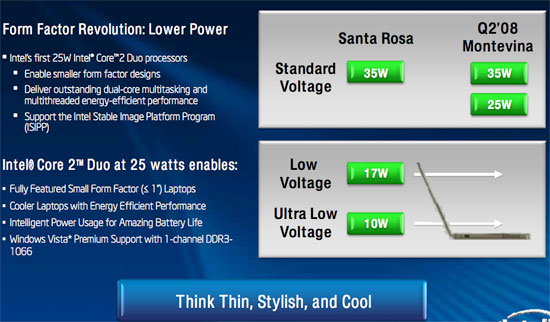
The three platforms we just mentioned however all carry a 34/35W TDP, but now at 2.4GHz with Montevina Intel has lowered the TDP by 10W to 25W. The lower TDP is made possible by dropping voltages a bit further, note that in its highest frequency mode the minimum Vcc has been lowered to 0.9V down from 1.0V. The end result is both lower voltages and lower maximum current draw than any previous Core 2 based Centrino platform.
The Montevina Rollout for the Rest of 2008
There's more Centrino 2 to come, by the end of this year Intel will add to the Montevina lineup with new small form factor chips. These chips all have the 22mm x 22mm package that was first used in Apple's MacBook Air:
| Core | Platform | Clock Speed | FSB | L2 Cache | TDP | Package | |
| Core 2 Duo SP9400 | 45nm Penryn | Montevina | 2.40GHz | 1066MHz | 6MB | 25W | 22mm x 22mm |
| Core 2 Duo SP9300 | 45nm Penryn | Montevina | 2.26GHz | 1066MHz | 6MB | 25W | 22mm x 22mm |
| Core 2 Duo SL9400 | 45nm Penryn | Montevina | 1.86GHz | 1066MHz | 6MB | 17W | 22mm x 22mm |
| Core 2 Duo SL9300 | 45nm Penryn | Montevina | 1.60GHz | 1066MHz | 6MB | 17W | 22mm x 22mm |
| Core 2 Duo L7700 | 65nm Merom | Santa Rosa | 1.80GHz | 800MHz | 4MB | 17W | 35mm x 35mm |
| Core 2 Duo L7500 | 65nm Merom | Santa Rosa | 1.60GHz | 800MHz | 4MB | 17W | 35mm x 35mm |
| Core 2 Duo L7300 | 65nm Merom | Santa Rosa | 1.40GHz | 800MHz | 4MB | 17W | 35mm x 35mm |
| Core 2 Duo SU9400 | 45nm Penryn | Montevina | 1.40GHz | 800MHz | 3MB | 10W | 22mm x 22mm |
| Core 2 Duo SU9300 | 45nm Penryn | Montevina | 1.20GHz | 800MHz | 3MB | 10W | 22mm x 22mm |
| Core 2 Duo U7700 | 65nm Merom | Santa Rosa | 1.33GHz | 533MHz | 2MB | 10W | 35mm x 35mm |
| Core 2 Duo U7600 | 65nm Merom | Santa Rosa | 1.20GHz | 533MHz | 2MB | 10W | 35mm x 35mm |
| Core 2 Duo U7500 | 65nm Merom | Santa Rosa | 1.06GHz | 533MHz | 2MB | 10W | 35mm x 35mm |
| Core 2 Duo U3300 | 45nm Penryn | Montevina | 1.20GHz | 800MHz | 3MB | 5.5W | 22mm x 22mm |
| Core 2 Duo U2200 | 65nm Merom | Napa Refresh | 1.20GHz | 533MHz | 1MB | 5.5W | 35mm x 35mm |
| Core 2 Duo U2100 | 65nm Merom | Napa Refresh | 1.06GHz | 533MHz | 1MB | 5.5W | 35mm x 35mm |
The Core 2 Duo SL9400 and SL9300 are prime MacBook Air replacement candidates, they run at slightly higher clock speeds, have more L2 cache and actually have a lower TDP than the chips in the MacBook Air (17W vs. 20W).
The Chipset: G45
The major component of Centrino 2, and a large part of the reason for its delay, is Intel's new GM45 chipset - the mobile variant of the desktop G45 chipset.
| Intel GMA X4500HD (GM45) | Intel GMA X3100 (GM965) | |
| Shader Processors | 10 | 8 |
| Core Clock | 533MHz | 500MHz |
| H.264 Decode Acceleration | Yes | No |
| TDP | 12W | 13.5W |
With 25% more shader processors and a 6.6% increase in clock speed, the GM45's integrated graphics is definitely a step up from the GM965 chipset, which was a part of the Santa Rosa Refresh.
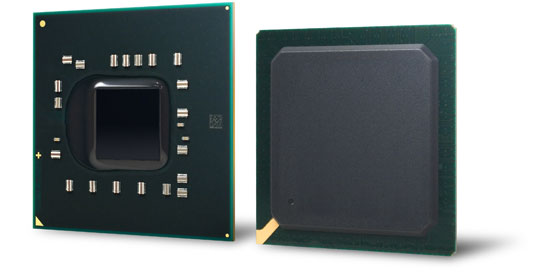
As we mentioned earlier in this article, we couldn't get the hardware video decode acceleration working properly on the GM45's integrated graphics. We used a beta version of Cyberlink's PowerDVD 8 Ultra (v8.0.1903.50) with support for GM45, but when playing back Gone Baby Gone we ran into some issues. CPU utilization did go down, but so did our frame rate. It was almost as if the video decode engine was only decoding half of the frames, the stuttering was that bad. Granted this is pre-release hardware, with pre-release drivers and a pre-release Blu-ray player, but going back to what we originally said - we expected a little more polish less than 30 days away from availability.
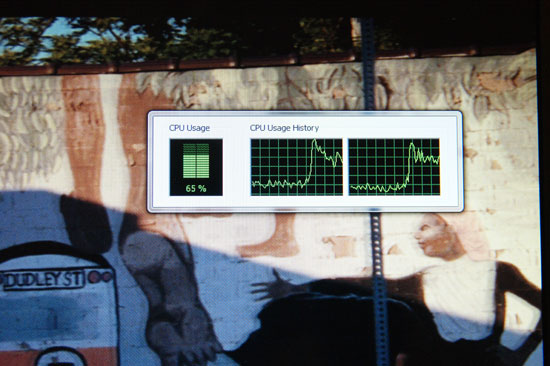
Blu-ray playback, hardware acceleration disabled
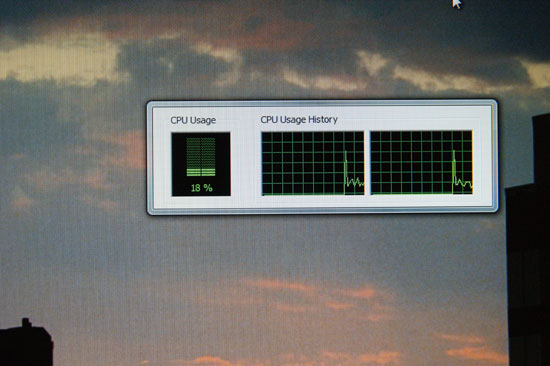
Blu-ray playback, hardware acceleration enabled - the CPU usage drops, but so does our frame rate
One interesting feature of the GM45 chipset is the ability to dynamically switch between integrated and discrete graphics, similar in nature to features announced by AMD and NVIDIA (e.g. NVIDIA's Hybrid Power). Unfortunately, our test system didn't have a discrete GPU so we couldn't test the feature ourselves. To make matters worse, Intel couldn't go into great detail about how the technology worked.

We're still waiting to find out how Intel's switchable graphics will work in practice
We were told that OEMs will either implement a hardware or a software switch to allow you to enable/disable discrete graphics, but we have no idea how it'll work. NVIDIA's implementation of a similar technology copies the frame buffer to main memory, using the integrated graphics core to output it to your display - Intel told us that its version doesn't work this way. Unfortunately we aren't sure if that means switching between integrated and discrete graphics will require a hardware reboot, or if it'll be possible to do so on the fly. We have more questions than answers here so it's better that we leave speculation alone and wait until it's something we can test ourselves.
Both the GM45 and its discrete graphics counterpart (PM45) support DDR2 and DDR3 memory, the latter being a newcomer to the mobile space. DDR2-667/800 and DDR3-800/1066 are both supported, although at the same data rate DDR3 should offer better battery life thanks to a lower operating voltage (1.5V vs. 1.8V). DDR3-667 support will eventually come with the release of SFF Centrino 2 platforms.
New Wireless Adapters
In order to be able to use the Centrino 2 brand, much like the original Centrino brand, an OEM must buy three components from Intel: 1) a Centrino 2 CPU, 2) a Centrino 2 chipset and a Centrino 2 WiFi adapter.
Intel used to only offer a single WiFi adapter, in the last version of Centrino that was the WiFi Link 4965AGN. This particular WiFi adapter featured support for 2 transmit antennas and 3 receive antennas, and was capable of sending up to two simultaneous data streams. With Centrino 2, OEMs have two options: the WiFi Link 5100 or 5300. The specs are below:
| Intel WiFi Link 5300 | Intel WiFi Link 5100 | Intel WiFi Link 4965 | |
| Transmit Antennas | 3 | 1 | 2 |
| Receive Antennas | 3 | 2 | 3 |
| Number of Concurrent Spatial Streams | 3 | 2 | 2 |
| Price (1000 units) | $29 | $19 | $29 |
The new WiFi Link 5100 supports the same number of spatial streams as the 4965 that's available in current Centrino notebooks, meaning that it can receive two streams of data concurrently, or transmit one stream and receive another at the same time. The third antenna in the 4965 is simply used to boost range, so it is possible that systems using the 5100 will have worse WiFi range than existing Centrino notebooks. Transmit performance can also be greater on systems equipped with the WiFi Link 4965, but the WiFi Link 5100 is $10 cheaper, which means we'll probably see it exclusively in cheaper notebooks.
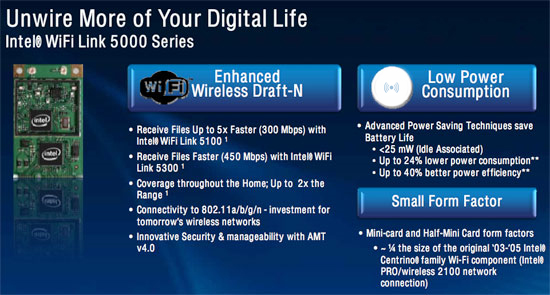
The WiFi Link 5300 is particularly interesting as it not only supports more transmit antennas than the old 4965, but it also supports more concurrent spatial streams. Range and performance should both be improved with a properly implemented WiFi Link 5300, unfortunately we weren't able to test this as our test system on shipped with a 5100.

In our tests, transmit performance between the 5100 and the older 4965 were identical, but receive performance was significantly worse. We suspect that this was more a problem with the storage setup on our test Centrino 2 notebook, disk read performance was great, write performance just wasn't. But our concern was transmit performance, and our initial tests show that the 5100 should at least offer the same performance as the older 4965 but at a lower price.
We're expecting the nicer notebooks to move to the 5300, which should hopefully improve performance beyond all previous Centrino wireless solutions.
Later this year Intel will also reveal WiMAX versions of these network controllers, but they weren't ready in time for today's launch.
Final Words
There's not much data to go on about making a conclusion here - Centrino 2 should be yet another evolutionary step over the previous generation Centrino. Processor performance hasn't really changed (thankfully our Centrino 2 test system was able to at least confirm this for us), and battery life should improve slightly thanks to lower voltage on the 25W TDP CPUs, the lower GM45 TDP and lower DDR3 operating voltage - but don't expect huge gains.
The new WiFi options are interesting, but what really matters there is how much more OEMs will charge for the 5300 over the 5100. With only a $10 difference in OEM cost, we have a feeling that the actual street price difference will be far greater. It also remains to be seen how big of a tangible performance increase we can see from the 5300 over the 5100.
Here's what we need from Intel or a capable OEM to truly determine the worth of Centrino 2:
- A fully working, fully optimized Centrino 2 notebook
- A similarly configured Santa Rosa Refresh notebook for comparison
- The ability to switch between WiFi Link 5300 and 5100 cards to truly determine their tangible value
- A Centrino 2 system with discrete graphics to truly evaluate how the switch between IGP and discrete graphics works
- Working GM45 drivers with full video decode support and proper application support for it as well. Many of these notebooks will be shipping with Blu-ray drives and in the interest of actually being able to watch a Blu-ray movie on a battery, hardware decode acceleration needs to work.
Until then, we can only conclude about Centrino 2 what we know on paper. It shouldn't really be any faster, clock-for-clock, than the Santa Rosa Refresh based Centrino notebooks. Initial results we've seen from OEMs that have gotten systems to work shows that performance and battery life of their new Centrino 2 systems aren't any different than their previous Santa Rosa Refresh systems. Compared to earlier Santa Rosa and Napa machines, the upgrade should be worth it, but if you just bought a notebook - don't be fooled by the 2, it's not time to upgrade.
Honestly the most exciting Centrino 2 CPU is one that isn't even launching today - the Core 2 Duo SP9400 runs at 2.40GHz but ships in a svelte 22mm x 22mm package (as compared to 35mm x 35mm), which should enable some fairly high powered, small form factor notebooks.
We're confident that Intel and its partners will bring Centrino 2 to market in the next month or so without problems, the brand is too big of a cash cow not to. We just wished that Intel would take its mobile launches as seriously as it does its desktop ones.













